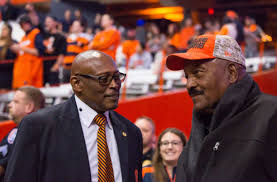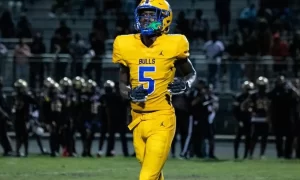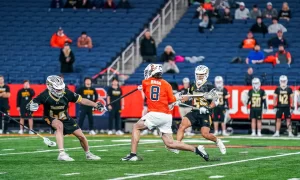One of the features of the Dome’s renovations in 2020 was the addition of a Ring of Honor, a way for Syracuse to honor athletes and coaches who made a lasting impact on the University. The inaugural class featured the 44s-Jim Brown, Ernie Davis and Floyd Little-representing the football program, with Jim Boeheim and Pearl Washington representing basketball. Former lacrosse coach Roy Simmons Jr. was inducted last Spring.
At halftime of next Saturday’s game against NC State, SU will honor the 44s with a ceremony to officially welcome the legendary trio into the Ring of Honor. Syracuse has a long and decorated history of athletes that did great things for the Orange and at the next level, but does that past have benefits for the future?
Names like Brown, Davis and Little are great for the fans to reminisce on and for SU to honor for what they did for the school. However, what do they mean in the eyes of a recruit, or, in other words, a 17-year-old kid whose ultimate goal is to get to the NFL?
The answer is virtually nothing because of how long ago those three played for Syracuse-Brown from 1954-56, Davis from 1959-61 and Little from 1964-66. Many recruits’ parents weren’t even born when those three were on the Hill.
Recruits can’t picture themselves following the paths of the 44s to the NFL. Everything is obviously different now, from the scouting process, to player development strategies, to coaching staffs, to NIL opportunities, etc.. The only potential benefit that the Ring of Honor could have is a “coolness” factor of playing for the same program as some legendary name. There isn’t a recruit anywhere who would actually make that a major part of their decision.
Maybe the biggest parts of their decision are the present state of the program and the recent past. For a running back recruit, Sean Tucker means way more than Brown, Davis and Little because Tucker provides a roadmap. He shows that the current structures in place can develop a three-star prospect into a sure-fire NFL draft pick.
The same can be said for SU’s lineage of defensive backs. Andre Cisco, Ifeatu Melifonwu and Trill Williams led to Garrett Williams and Duce Chestnut, who led to transfers like Alijah Clark and Isaiah Johnson and freshman Jeremiah Wilson.
It’s about creating a pipeline and a winning culture that recruits want to be part of. Syracuse hasn’t had that in recent memory, now it does. The Orange have 10-12 players with a real chance of at least having a shot in the NFL. SU also has a 5-0 record for the first time in 35 years.
This season has shown that Dino Babers can do both: develop players and win games. That’s how you attract great recruits. As much as the Ring of Honor and Syracuse’s history as a whole is meaningful to fans and should be recognized, it isn’t going to convince anyone to play at SU now.


















